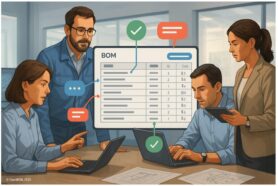
Engineering and manufacturing industries are evolving at a rapid pace, driven by the increasing complexity of products and processes. This evolution involves the integration of diverse disciplines such as mechanical engineering, electrical/electronics, software development, and many others. Adapting to this change is not straightforward; it necessitates a significant paradigm shift in data management strategies.
Companies involved in a new product development process are usually exposed to a substantial level of complexity in managing the process and information that is needed for decision-making. A proper tracing of all information and decision-making later has an impact because of companies’ liability, regulation control, supply chain, and many other factors. But the information is “lost in transition” in zillions of emails, temporary Excel files, and other information sources.
Document Centric: Evolution of Traditional Files/Folders
A traditional PDM/PLM approach gives a structured mechanism that replicates decades-old folders and files concept. This is how CAD systems were organizing information for the last 30-40 years and it was replicated to be supported for databases with records and revisions. This is why most traditional, PDM and PLM systems, like Solidworks PDM and many others, have focused on document-based control, emphasizing the management of file revisions.
However, this approach raises a crucial question: What happens in the myriad interactions and decisions that occur between revisions in different systems? How do we integrate and manage data across multiple activities in different systems and disciplines? The traditional document-centric model often leads to fragmented and uncontrolled information. Companies, even large ones, frequently resort to using Excel, Google Sheets, or Airtable to bridge the gaps, inadvertently creating vast pools of unmanaged data.
The challenge then becomes how to connect all this disparate information and provide a collaborative platform for tracking communication and decisions across teams – engineers, production planners, procurement and supply chain, contract manufacturing companies, and others.
Data-Driven Connected Paradigm
At OpenBOM, we’ve been thinking about how to offer a better way for the product development and manufacturing team to manage information and collaborate during the new product development process. This process is complex and involves multiple stakeholders and pieces of information combined. It also requires interaction with multiple design systems and demands to make the data open and available to everyone across the organizational boundaries. The last is a burning need because pulling data from systems and sending it in Excel or pulling them to Google Sheets and Airtable compromises security and makes manufacturing companies vulnerable to IP theft.
Collaborative Grid: The Foundation of OpenBOM
OpenBOM introduces a paradigm shift with its Collaborative Grid, a structured space designed to manage product structures (Bill of Materials, or BOM) in a manner that is seamlessly accessible and editable by all stakeholders in real-time, akin to a Google Sheet on PLM steroids. This customizable, change-tracking environment enables the management of a reference instance model for item masters, serving as a central hub for information from multiple systems.
Seamless CAD Integration
OpenBOM’s integration capabilities with CAD systems ensure that data from multiple sources can be brought together without locking the data into a single format or system. It automatically merges changes, facilitating a dynamic and flexible data management environment.
Traceability and Revision Control
The system’s revision control functionality allows for the saving of revision “snapshots,” enabling users to maintain a history of changes and facilitate comparisons over time, ensuring traceability and accountability.
Configurable User-Defined View Mechanism
OpenBOM offers a configurable view mechanism that controls access to information based on user roles and requirements. This ensures that sensitive or irrelevant information is accessible only to those who need it, enhancing security and efficiency.
Organization Benefits Of New “Connected” Approach
By aggregating all information in a collaborative, visual, and connected form, OpenBOM addresses the disconnect inherent in traditional document-driven systems. It supports the use of traditional PDM for file management or offers its own Design Projects PDM service for cloud storage and synchronization with local folders.
Conclusion
The landscape of traditional PDM/PLM is undergoing a transformation. OpenBOM’s SaaS service represents a significant advancement in collaborative engagement among engineers, manufacturers, supply chain professionals, and procurement teams. It tracks all activities in real-time, providing seamless access to information and facilitating efficient product development and manufacturing processes. For those looking to move beyond the limitations of traditional PLM systems, OpenBOM offers a compelling solution. To explore these benefits firsthand, registration is open and free, providing instant access to OpenBOM’s innovative platform.
In a world where collaboration and agility are key to innovation, OpenBOM’s approach to PLM could very well be the blueprint for the future of manufacturing and engineering systems, complementing traditional Systems of Record and providing a way to collaborate and gather IP that is usually lost in the organization.
REGISTER FOR FREE and check how OpenBOM can help you today.
Best, Oleg
Join our newsletter to receive a weekly portion of news, articles, and tips about OpenBOM and our community.










